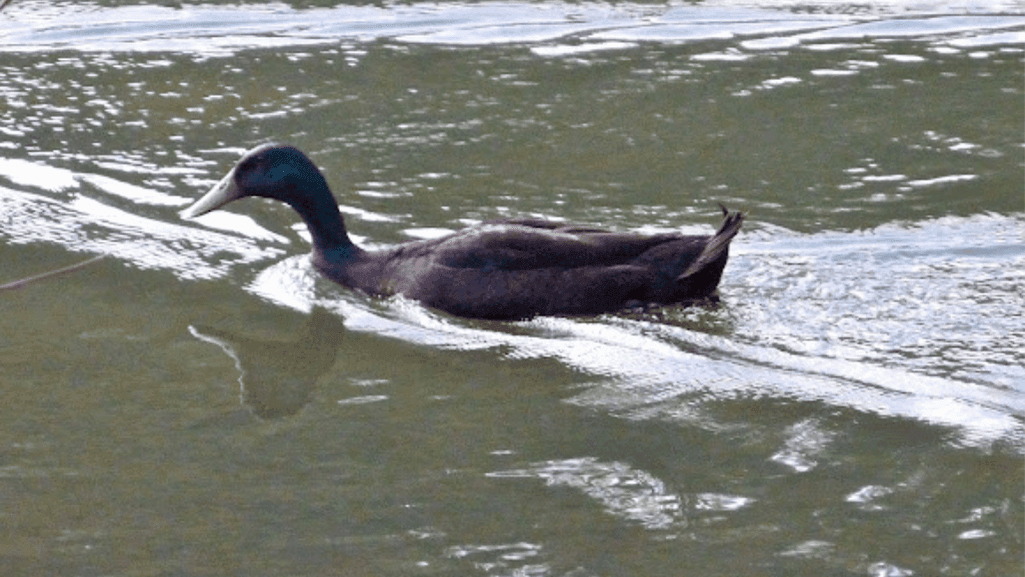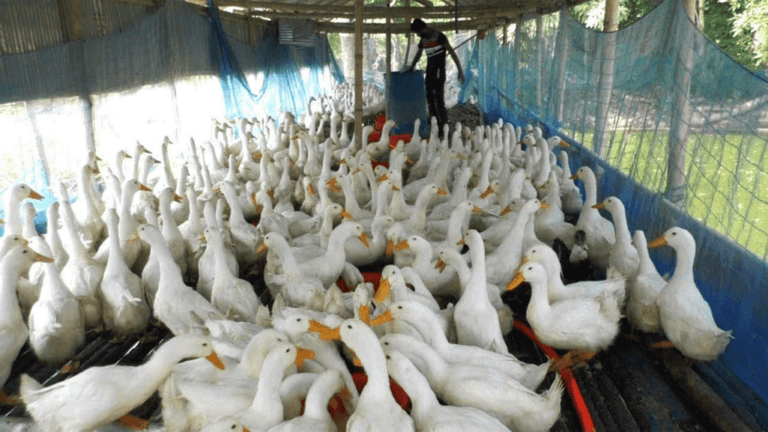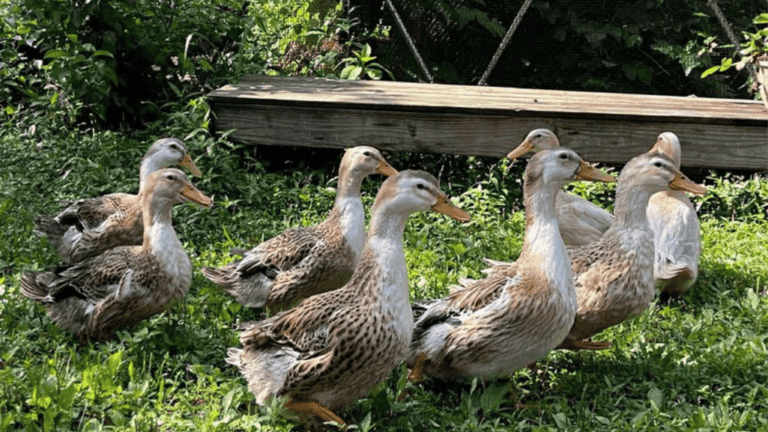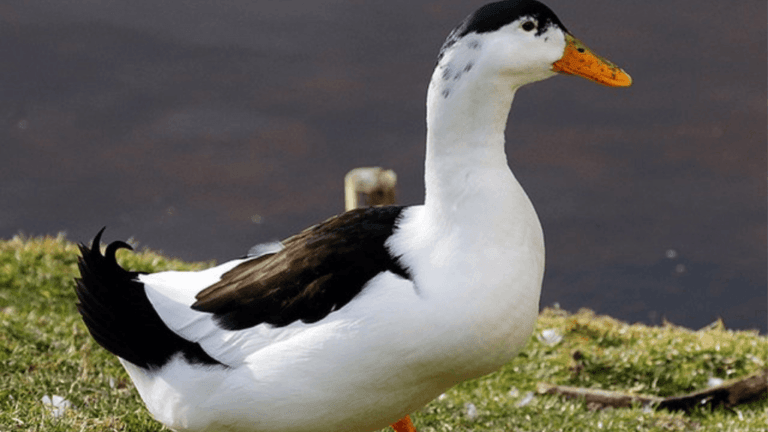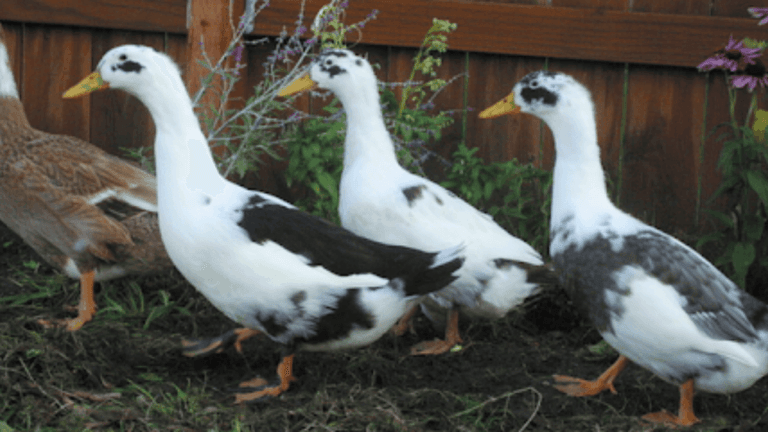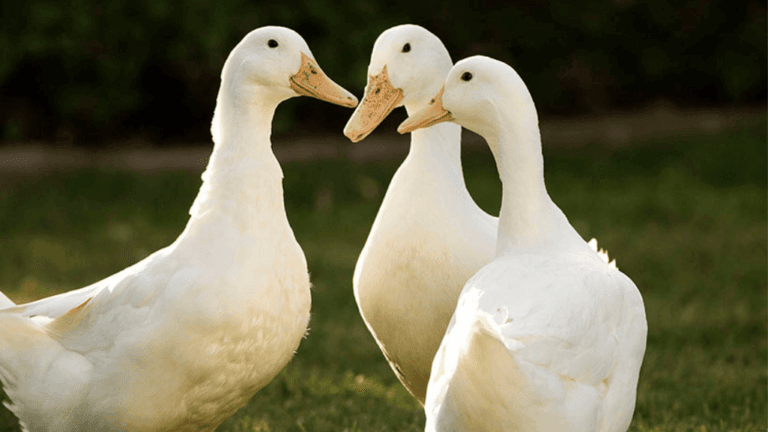Discover the charm of Black Runner Ducks, a breed that’s winning hearts among poultry lovers. They stand tall with their sleek black feathers, making them a standout on any farm or homestead.
Black Runner Ducks are part of a family known for their upright posture. They’re small, weighing 3-4 pounds, but they’re great at laying eggs. They can lay 100-180 eggs a year, and these eggs often have a unique bluish tint.
These ducks are great at foraging and laying eggs, but they can be a bit nervous. They love to move in groups, creating a fascinating sight on your property. Despite their nervousness, they’re easy to care for and fit well into many farm settings.
Key Takeaways
- Black Runner Ducks are known for their upright stance and dark coloration
- They’re excellent foragers and good egg layers
- These ducks produce 100-180 eggs per year, often with a bluish tint
- Black Runner Ducks have a nervous temperament and tend to move in groups
- They’re low-maintenance and adaptable to different farm environments
Introduction to Black Runner Ducks
Black Runner Ducks are a special type of waterfowl with a long history in poultry farming. They belong to the Indian Runner duck family. These ducks stand out because they move quickly and walk upright.
Origin and History
These ducks come from Southeast Asia, not India, despite their name. They have been around for over a thousand years, as shown by ancient stone carvings in Java. European traders first saw them in Malaya in 1851 and Lombok, Indonesia in 1856.
They made their way to England in the 1850s. They were mistakenly called “Indian” because of the trade routes.
Physical Characteristics
Black Runner Ducks are also known as ‘Penguin Ducks’ or ‘Bottle Neck Ducks’. They have a unique look:
- Long, slender bodies
- Vertical posture
- Quick, upright gait
- Sleek black plumage
Temperament and Behavior
Black Runner Ducks have traits that make them great for poultry farming:
| Trait | Description |
|---|---|
| Foraging | Excellent pest control, covering large areas |
| Noise Level | Quieter than most duck breeds |
| Social Behavior | Thrive in flocks, need companionship |
| Activity Level | Highly active, enjoy running |
These traits make Black Runner Ducks a great choice for any backyard duck setup. They are active and help control pests, making them useful for both small and large farms.
Benefits of Raising Black Runner Ducks
Black Runner ducks are a great choice for those who love keeping ducks. They mix productivity with charm, making them popular among poultry keepers. Let’s look at why Black Runner ducks are a top pick for many.
Egg Production
Black Runner ducks are known for their high egg production. They don’t lay as many eggs as Indian Runners, but they still help a lot. Their eggs are bigger than chicken eggs, weighing 65-80 grams.
About 70% of their eggs have a bluish tint, adding color to your egg basket.
Foraging Abilities
Black Runner ducks are amazing at foraging. They can cover long distances to find food, controlling pests in gardens. Their light weight, about 4 to 4.5 pounds, means they won’t harm plants while foraging.
Low Maintenance Requirements
Black Runner ducks are easy to care for, perfect for beginners. They live for 8 to 10 years, offering long-lasting companionship. These ducks are tough and easy to care for, needing only basic poultry care.
They stand upright and move a lot, so they don’t need much space. This makes them great for smaller farms or homes.
| Characteristic | Black Runner Ducks |
|---|---|
| Weight | 4 – 4.5 pounds |
| Egg Production | 100 – 180 eggs per year |
| Egg Color | 70% bluish |
| Lifespan in Captivity | 8 – 10 years |
For those interested in duck keeping, Black Runner ducks are a great choice. They offer egg production, pest control, and are easy to care for. Their unique traits make them perfect for both new and experienced duck keepers. For more info on duck care and different duck breeds, check out reliable sources.
Setting Up Your Black Runner Duck Habitat
Creating the perfect duck habitat is key for raising healthy Black Runner Ducks. Start with a clean, disinfected space like a barn, out-building, or poultry coop. These areas offer shelter and protection for your backyard ducks.
For ducklings, use a brooder ring made of cardboard. It should be 18 inches high with a heat lamp on top. Each duckling needs about 1/3 square foot of space at first. As they grow, increase their space to match their active nature.
Bedding is crucial in duck farming. Use 2 to 4 inches of dry litter like pine wood shavings or chopped straw. Avoid newspaper, cedar chips, or dusty sawdust. Keep the bedding clean and dry to prevent health problems.
Adult Black Runner Ducks need a well-designed outdoor area. Create a wire platform over a ground pit for their water area. This setup keeps the pen dry, which is vital for a healthy environment in your duck habitat.
Black Runner Ducks love to forage. Give them enough space to run and explore. This keeps them happy and helps with pest control in your yard. With the right setup, your Black Runner Ducks will do great in their new home.
Caring for Black Runner Ducks
Proper care is key for Black Runner Ducks in poultry farming. They need a special diet, clean water, and good health to do well.
Feeding Guidelines
Black Runner Ducks eat a varied diet. They like to forage for slugs, worms, and insects. Wheat is a great food for them, packed with protein and vitamin B. For ducks that lay eggs, special pellets with calcium and phosphorus are a must.
- Ducklings: Start with duck-specific starter ration, not chick crumbs
- Growing ducks: Transition to duck grower pellets
- Laying ducks: Provide layers pellets with extra calcium
- Breeding ducks: Offer breeder pellets with higher vitamins A, D, and E
Water Requirements
Clean water is crucial for Black Runner Ducks. Make sure they have plenty of room-temperature water in clean containers. For ducklings, introduce swimming water carefully from one week of age, making sure they can easily get in and out.
Health Considerations
Keep an eye on the brooder temperature for ducklings, starting at 95°F and dropping by 5°F each week. Give them enough space to move around to avoid weak legs and rough feathers. By 5-6 weeks, let them swim freely as their oil glands grow. Regular health checks and a balanced diet are important for keeping your waterfowl healthy.
Black Runner Ducks vs Other Duck Breeds
Black Runner Ducks are unique among duck breeds. They mix practicality with beauty, making them a favorite among duck lovers.
Comparison with Other Runner Duck Varieties
Black Runner Ducks are part of the Runner Duck family, which also includes Fawn and White, Chocolate, and Blue varieties. They breed true, keeping their unique color through generations. The British Waterfowl Association gives 27 pages to Runner ducks in their standards review, showing their significance.
Each Runner type has its own color rules. Black Ducks should not have a lot of brown or white feathers. Chocolate Ducks with green bills are not allowed. Fawn & White ducks need symmetrical markings, but irregular patterns are okay.
Advantages over Traditional Duck Breeds
Black Runner Ducks have many benefits over traditional ducks. They stand tall and move fast, unlike heavy breeds like Aylesbury, which can get up to 10 pounds. Their light weight means they won’t damage gardens, great for backyard duck keepers.
They lay about 100-180 eggs a year, less than some breeds like the Golden 300 Hybrid. But Black Runners are great for their looks and foraging skills. This makes them a good choice for those wanting eggs and ornamental ducks.


